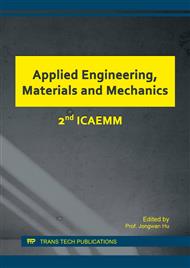[1]
Copper Development Association, Electrical Energy Efficiency, New York: Copper Development Association, (1997).
Google Scholar
[2]
T. Shen, Economic operation analysis of cable lines, Guangdong Electr. Power, 19(12) (2006) 34-38.
Google Scholar
[3]
F. Guo, K. Wen, G. F. Li, Design of Life Cycle Costs for Power Transmission Line, Electr. Power Construct. 32(2) (2007) 13-16.
Google Scholar
[4]
C. Xu, Research of the application in power equipments' LCA management, Electr. Power, 43(3) (2010) 72-74.
Google Scholar
[5]
International Electro-technical Commission, IEC Std 60300-3-3. Dependability management application guide of life cycle cost, Geneva, Switzerland: IEC, (2004).
Google Scholar
[6]
S. S. Zha, J. Y. Zheng, J. J. Hu, Selection of main electrical connection of a 500 kV substation in initial stage based on idea of life cycle cost, Power Syst. Technol. 34(3) (2010) 117-121.
Google Scholar
[7]
J. W. Guo, J. D. Xie, G. Q. Tang, Life cycle cost analysis in electrical equipment management, High Voltage Eng. 29(4) (2003) 13-16.
Google Scholar
[8]
C. H. Yang, Transformer bidding based on life cycle costs, Yun Nan Electr. Power, 39(3) (2011) 27-31.
Google Scholar
[9]
L. P. Ye, C. C. Qi, etc. Life cycle assessment of polyvinyl chloride production and its recyclability in China, J. Clean. Prod. 142(Part 4) (2017) 2965-2972.
DOI: 10.1016/j.jclepro.2016.10.171
Google Scholar
[10]
G. Liu, J. Y. Cao, etc. Selection Criteria of High-voltage Submarine Cables for Offshore Wind Farms by Life Cycle Cost, High Voltage Eng. 41(8) (2015) 2674-2680.
Google Scholar
[11]
H. P. Zhang, Study on Cost of Green Building Based on Life Cycle Theory, Chongqing University, (2012).
Google Scholar
[12]
C. J. Wang, Electric wire manual, China Machine Press, 2009, 1115-1166.
Google Scholar
[13]
China National Standardization Management Committee, GB/T 3956-2008. Conductors of insulated cable, Beijing, China Standard Press, (2008).
Google Scholar
[14]
China National Standardization Management Committee, GB/T 12706-2008. Extruded insulated power cable and accessories from 1kV (Um=1. 2kV) to 35kV (Um=40. 5Kv, Beijing: China Standard Press, (2008).
Google Scholar
[15]
China National Standardization Management Committee, GB/T 1179-2008. Round wire concentric-twisted overhead conductor, Beijing: China Standard Press, (2008).
Google Scholar
[16]
Y. H. Wu, A. Y. Chen, Z. Wang, D. Z. Sun, Life Cycle Assessment of Polyvinyl Chloride Production, Environ. Sci. Technol. 23(5) (2010) 46-50.
Google Scholar
[17]
M. Li, Z. Wang, D. Z. Sun, Study on Life Cycle Assessment of Polythene Production, Environ. Sci. Technol. 32(5) (2009) 37-39.
Google Scholar
[18]
H. Xie, H. M. Liu, B. H. Qiu, Y. R. Yan, Life Cycle Assessment of Polypropylene Production and Comparison with Polylactic Acid, Chem. Fiber Text. Technol. 40(2) (2011) 56-61.
Google Scholar
[19]
J. L. Jiang, J. F. Dai, W. J. Feng, J. C. Cheng, Life cycle assessment of metallic copper produced by the pyrometallurgical and hydrometallurgical processes, J. Lanzhou Univ. Technol. 32(1) (2006) 20-25.
Google Scholar
[20]
M. X. Han, Q. H. Sun, Q. Qiao, X. S. Yang, Pollutants Emission Scenario Analysis of China Copper Smelter Industry, Environ. Sci. Manag. 34(12) (2009) 38-43.
Google Scholar
[21]
X. Mao, Life Cycle Assessment of Terylene Textile, Shanghai: Dong Hua University, 2006, 12.
Google Scholar
[22]
Z. Q. Gong, A Quantitative Method to the Assessment of the Life Cycle Embodied Environmental Profile of Building Materials, Beijing: Tsinghua University, 2004, 6.
Google Scholar


